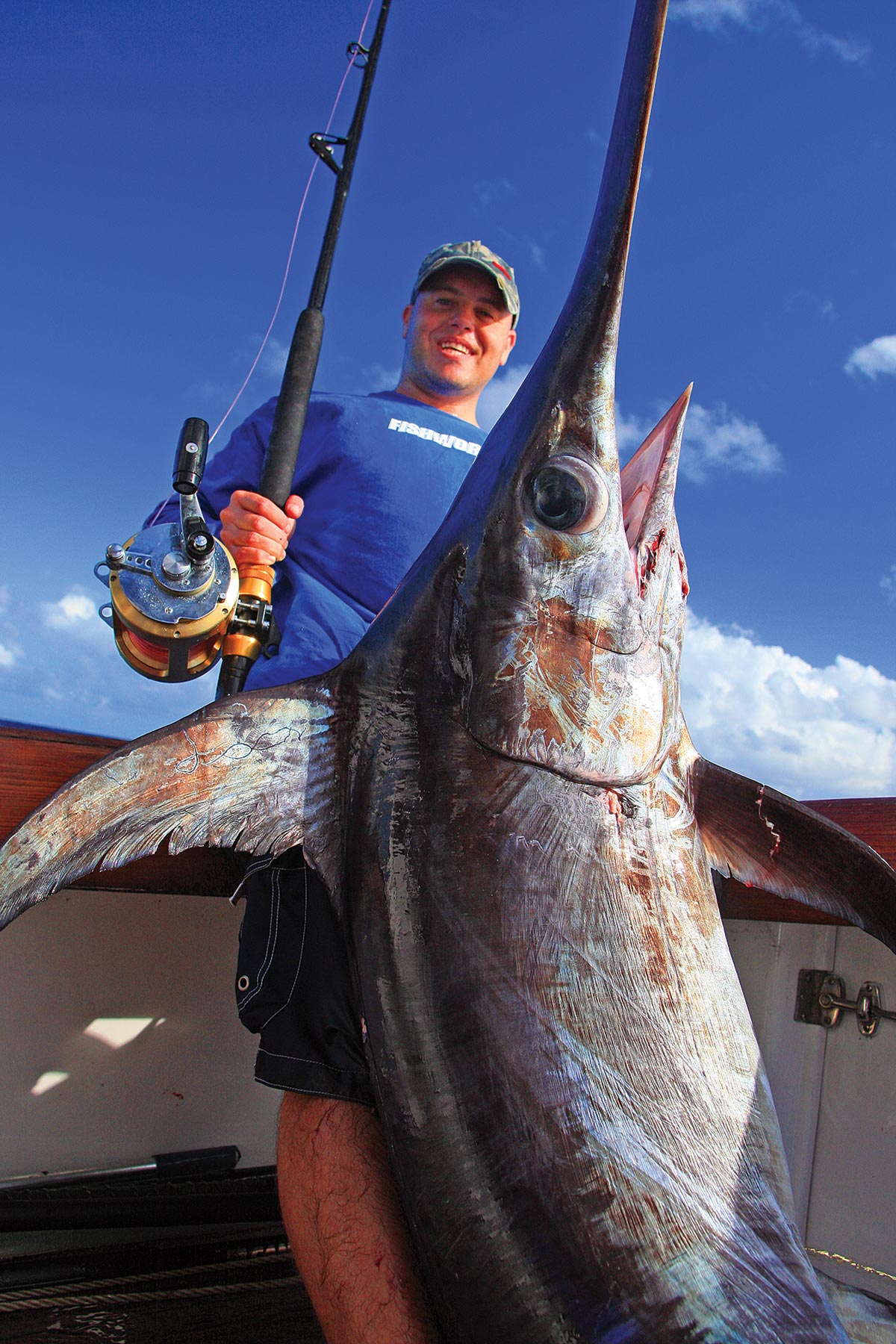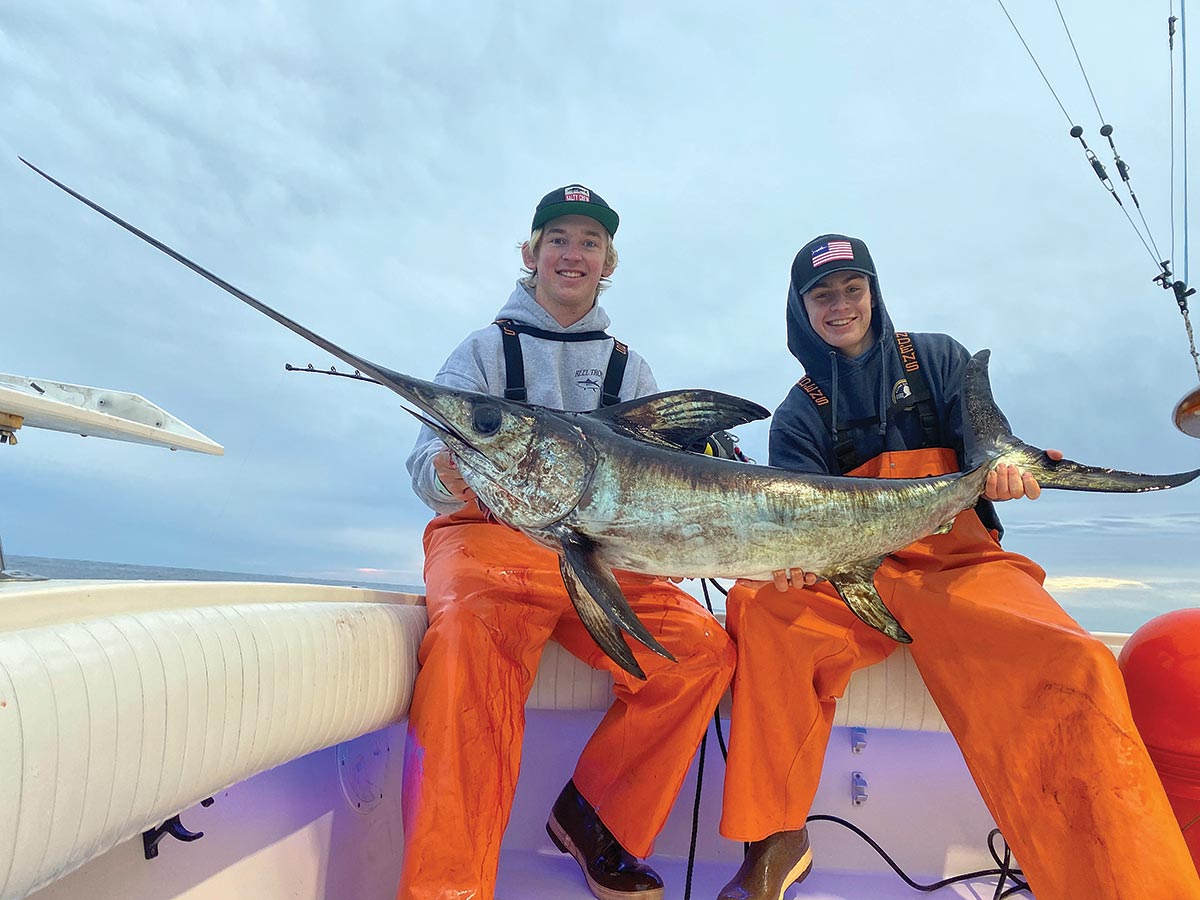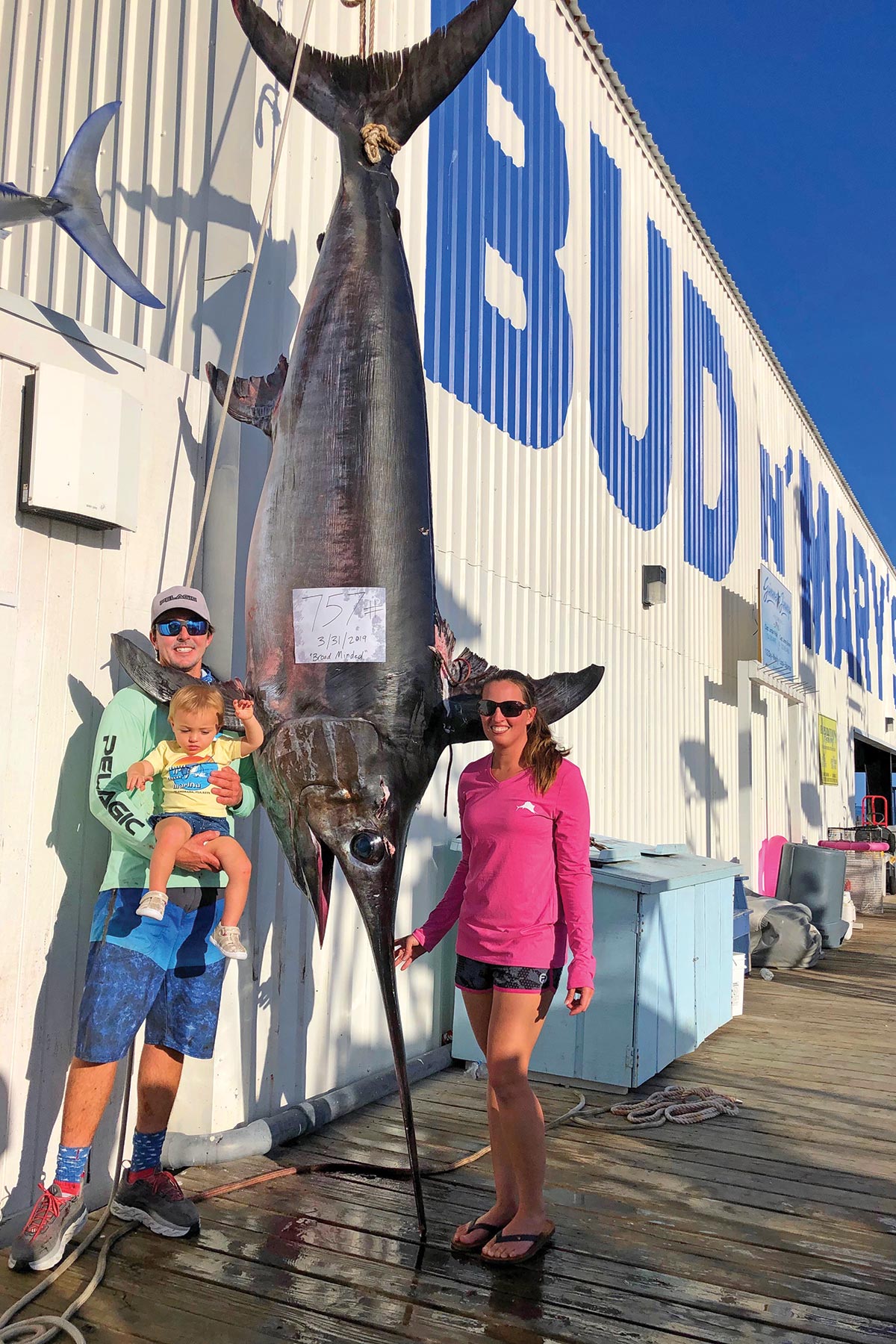Northeast anglers may want to take a page from their Southern brethren when it comes to targeting daytime swords.
 The title of this article could have been used many decades ago when swordfishing was strictly a daytime proposition. A great deal has changed since it was necessary to spot swordfish on the surface in order to catch them either by spearing or with hook-and-line.
The title of this article could have been used many decades ago when swordfishing was strictly a daytime proposition. A great deal has changed since it was necessary to spot swordfish on the surface in order to catch them either by spearing or with hook-and-line.
Most offshore fishermen these days have probably never seen a swordfish on the surface, but the chances of catching one with rod and reel in the daytime may be better than ever as fishermen have found quantities of a previously rare catch in the great depths off the Northeast and Southern coasts.
As a youngster growing up on Long Island, I practically wore out books by wealthy fishing authors such as S Kip Farrington Jr., Van Campen Heilner and Zane Gray as they recounted their travels around the world in search of trophy gamefish such as giant bluefin tuna, marlin and swordfish. One thing they all had in common was they were in agreement that the greatest challenge of all was the broadbill swordfish.
I never expected to catch a swordfish myself, an assessment that proved correct while trolling for 100- to 200-pound striped marlin off Ecuador. Using just 30-pound class tackle, a sword came up and ate the small ballyhoo I was trolling (a very rare event). It was the beginning of a 12-1/2-hour battle with a sure line class world record that ended when something cut my leader at night.
By Hook Or Harpoon
There actually were a lot of swordfish in U.S. waters on both coasts not too far from shore a century ago. Harpooners found many easy targets, and earned relatively good money for that time with their catches. The first swordfish (355 pounds) was caught in 1913 on pretty basic big game tackle off California, but the best Atlantic (primarily from Shinnecock to Montauk) sportfishing skippers of that time soon developed a technique for baiting surfacing swords which could rarely be tempted to take a trolled bait. They assumed those fish must have been feeding in the depths, and were sunning themselves on a full stomach – which turned out to be basically the case.
Fishermen will usually find a way, and that involved dropping a bait in front of the swordfish to make it an easy target they couldn’t refuse. On the West Coast that was done by using a kite, while Atlantic skippers stripped coils of line (linen in those days) off the reel and laid it on deck or the bridge as the bait was trolled in front of the fish. The boat was then taken out of gear and the slack tine thrown over to provide a slow drop. Most swords still ignored that effort, but there were often many opportunities to bait these fish. Farrington didn’t begrudge commercial fishermen harpooning swordfish for a living, but expressed contempt in his books for the wealthy so-called sportsmen who harpooned baited swords which were unresponsive to their offerings.
In his book Swordfish, author Richard Ellis noted that ever-increasing commercial pressure in the North Atlantic resulted in a drop in the average size of swordfish caught from 266 pounds in 1963 to just 90 pounds by 1995. That figure would have been much lower if longliners weren’t dumping many of the small swords they were catching due to a lack of market for those pups. The mercury fish scare in 1970 had greatly reduced pressure on swordfish, but it wasn’t long before they were back on menus.
As conservation concerns mounted and NOAA Fisheries failed to take action against longlining, Sea Web and the Natural Resources Defense Council recruited leading chefs in a Give Swordfish a Break campaign that took them off menus to protest all the juveniles being killed by longliners before they had a chance to reproduce. In 1999, NOAA Fisheries finally closed nursery areas along the Atlantic Coast to longlining which has contributed greatly to the overall health of the stock.
The volume of hits being recorded during daytime swordfishing reflects the protections now accorded to swordfish, but conservationists have had to be vigilant to fend off attempts to get longlines back in the nursery areas – often under the guise of gear experiments and scientific studies.
While this was an exciting sport, it was basically one for those able to afford charters with the best skippers, or owned boats and could afford to run around all day looking for surfacing fish. Having a good crew aboard was also essential in order to spot the big billfish on the surface. Another problem was the “soft” mouth of the swordfish. The late Capt. Carl Darenberg of Montauk Marine Basin told me he’d never seen a sword landed there that wasn’t foul-hooked by the double-hooked baits as they pulled out of the mouth during the fight. It wasn’t an easy sport fishery, but it was good enough to support some tournaments during the prime late spring and early summer periods on eastern Long Island and some New England ports.
Though harpooners greatly reduced the number of targets, that method actually was a much better commercial technique than what was to come as only large swords that had probably already spawned were targeted. Even though the numbers of sunning swordfish declined, there were many more below that weren’t being exploited.
Swordfish are well adapted for reproduction. In his book Swordfish (University of Chicago Press, 2013), Richard Ellis notes that “Female swordfish grow larger and live longer than males. They reach their maximum size (1,000 pounds or more) at about 15 years of age, but are sexually mature at about the age of five. A female swordfish releases 3-16 million eggs per spawning; after the eggs are fertilized they take 2.5 days to hatch and become larvae that immediately feed and fend for themselves.”
Angling & Science
Famous New Jersey big game angler, Lou Marron, set the IGFA record for swordfish with a 1,182-pounder caught on May 7, 1953 off Iquique, Chile, and his wife Eugenie was also the envy of most men as she boated a 772-pounder there, which is still the IGA woman’s world record in the 130-pound test line class.
But there was little scientific information about swordfish habits until California marine scientist Dr. Frank Carey ran experiments that showed they weren’t completely cold-blooded. The small amount of heat they developed provided more power, and adapted them for feeding in the cold depths. Carey also wanted to trace their movements, and Milton Shedd, owner of AFTCO and Sea World, was willing to help.
On April 30, 1977 I joined Milt, his son Bill (now president of AFTCO), and others aboard the Sea World collecting boat at Cabo San Lucas off Baja where we found many swords on the surface off Palmilla. Carey darted one with an acoustic tag within an hour, then we followed that fish as he tracked its movements with a hydrophone.

Much was learned before we lost contact in seas so rough that the long pulpit was cracked. Along with subsequent experiments, it became clear that swordfish movements are related to light, as they move inshore and upward at dusk and down into the depths at dawn. Changes in depth are greatest at dawn and dusk, with the deepest penetration being around noon. Of course, those swords which come to the surface, likely to warm themselves, are the exception.
What we went through to get that information in 1977 seems so primitive now, since that same info can be acquired far more effectively by simply implanting an expensive satellite tag, al la Gray FishTag Research, and going ashore to wait for the results!
The longlining explosion changed everything. Great numbers of swordfish were landed, and sightings of those fish on the surface soon became so unusual that few sportsmen pursued them any longer. The longliners had proved there were lots of swordfish out of sight, but what were the chances of catching one with only a few lines from a sportfishing boat compared to the longliner’s miles of line and thousands of hooks? As it turned out, those odds weren’t so bad as anglers in Miami developed techniques for night fishing during long drifts in the Gulf Stream which produced swords with regularity, and enough of them to run successful tournaments.
Keys To Heaven
Capt. Richard Stanczyk was a Keys swordfishing pioneer in the night fishery out of his Bud ‘N Mary’s Marina in Islamorada. He thought he was in Heaven as swords of all sizes hit his drifted baits at a time when there weren’t even 100 fishermen in the world who had ever caught a swordfish on sportfishing tackle.
Northern anglers had only recently started fishing the canyons by trolling for tuna and white marlin during the day, and it took some time before they started staying into the night to chunk tuna. Some finally began setting out swordfish baits at night, and there were additions to the list of anglers who have caught a swordfish on IGFA-approved tackle.

Stanczyk didn’t sit on his night fishing laurels. Instead he started devising means of catching swords in the great depths where they live during the day. In order to do that in legitimate sportfishing fashion, he had large flat-bottomed concrete blocks constructed at the marina that could be lined up on deck and tied on with 12-15-pound mono that would break off when a fish was hooked.
The thought of fighting a big swordfish up from such depths was daunting, but it turned out that swords cooperate by coming up when hooked. When my son Mike graduated with his MBA from Richard’s alma mater, the University of Miami, I took him down to Islamorada to fish with Richard and his brother on Catch 22 from Bud ‘N Mary’s for the recently discovered daytime swords.
That was a rare opportunity for Mike to catch a great gamefish, which in my youth I never even dreamed of being able to catch in my lifetime. Things didn’t start well on the first drift as what appeared to be a light hit resulted in Mike (an Ironman) having to reel the concrete block all the way up as the light mono didn’t break and we weren’t sure that a small sword wasn’t on until the reel was almost full. Fortunately, everything went right after that as Mike and I were both able to catch swords. It was tedious filling the spool of a Penn International 80 with 80-pound braid before the fight really started within about 200 feet of the boat, and when swords sometimes jump.
We had trolled some dolphin and blackfin tuna on the way out, and caught more dolphin during the drift. They provided us with an ideal bait — dolphin belly with the circle hook sewed in. The swords we kept only had small bottom fish in their stomachs though Richard says 75 percent of what is usually found in swordfish stomachs is squid.
Yet, swordfish appear to be opportunistic feeders — eating whatever is available. Marine artist Guy Harvey brought in a large swordfish one night when I was in Venezuela that had a stomach full of cutlassfish which were, amazingly, side by side as if positioned in a fish market. The best bait is one that can’t be torn off or nibbled to pieces by small fish. Checking the bait is something you don’t want to have to do when fishing these depths.
The Day Bite
Richard Stanczyk no longer fishes for swordfish, but his son, Nick, has become the hottest swordfish skipper in the Keys by catching them with consistency, often several per trip, and some huge ones such as last year’s 757-pounder. He’s also tagged and released a great many swordfish.

As with most daytime swordfish charter captains, he now fishes primarily with electric reels which the average angler can handle and enjoy the end of the fight near the boat. Of course, those fish caught by pushing a button don’t count by IGFA standards, and you won’t be able to join the thin ranks of those who have caught a swordfish in accordance with sportfishing standards.
While talking with Adrian Grey of the IGFA, we found that the organization doesn’t have any set standard for weights that can be used, but that is covered by the general provision which prohibits any rigging encumbering the fish’s fighting ability. A huge sinker certainly falls into that category, but now there’s a way to walk in the footsteps of Zane Grey and Ernest Hemingway without having to waste expensive sinkers.
A practical method of catching a legitimate IGFA daytime swordfish has been developed — and the IGFA has a tutorial on You Tube in which famed Miami skipper Bouncer Smith illustrates the technique. Basically, it involves using two rods. One with an electric reel acts as a downrigger and carries to bottom the 15-pound weight required in the Gulf Stream current, plus the line from the fighting rod on a snap which will open up under pressure. This also makes it possible to use lighter line classes in search of records or lighter tackle with enough capacity for a stand-up fight. The only problem doing that is the bait you’re holding just off bottom in great depths may be taken by a short swordfish or a 500-pounder, and you’ll never know that until you’re hooked up. Most swordfish pros have found that they are catching more very large swords during the day than they ever did at night.
Actually, I caught my first daytime swordfish in Venezuela – where they fish quite differently, and with smaller weights. Instead of long drifts over basically open bottoms, they fish the same way as at night by backing into the sea over a sharp drop-off within sight of the airport, though with lines set much deeper. Tall cartoon balloons are still used to help determine hits. Not as much sinker weight is required in this system, since you’re backing down to maintain position, and it can be just as tough to determine if there’s really a fish on at times before getting it close to the surface.
Back At Home
The volume of swordfish available to Northeast anglers is illustrated by the experience of Capt. Chris Di Stefano, who fishes aboard Frank Criscola’s Crisdel from Brielle Yacht Club in New Jersey. Last year they switched to swordfishing when yellowfin and bigeye tuna weren’t being raised on the troll. That happened quite a bit during the summer, but a move out to 1,700 feet on uneven bottom always bailed them out. It’s true that most of the swords are small, but they can be released until a real keeper comes along.
The minimum length for recreational fishing is 47 inches on a straight line from the tip of the lower jaw to the fork of the tail. One per person is allowed, with a limit of six per boat.
Currents to the north aren’t as strong as in Florida, and 8 to 10 pounds should do the job in most wind conditions. As little as 4 pounds can be used on calm days. Be aware of the fact that there are times when those sinkers bury themselves in the mud upon impact. Di Stefano says they usually use little tunny belly baits with the circle hook sewn in. Backing down at times helps keep the bait near bottom.
Bud ‘N Mary’s Marina
Islamorada, FL
800 742-7945
Canyon Runner Charters
Point Pleasant, NJ
732 272-4445
Capt. Nick Perello
Beach Haven, NJ
609 678-7141
The Canyon Runner fleet out of Point Pleasant, NJ has posted great canyon trolling results in recent years, and catches some swordfish at night – but the crew has experimented with the daytime swordfishery. Capt. Deane Lambros uses both 12- to 14-inch squid and strip baits in 900 and 1,400 feet, and one day caught seven out of 12 hits. He also tried for swordfish in North Carolina one winter, but was “sharked-out.” Bigeye thresher sharks also feed in the great depths, but they are a protected species which must be released. A bigeye tuna is also an outside possibility.
Capt. Nick Perello is a young skipper experimenting with his 28- foot Carolina Classic out of Beach Haven, NJ. He has tried at depths from 1,000 to 2,000 feet, but is usually fishing in 1,200 with large rigged eels. Nick also fishes for swords off Miami, but feels there’s better bottom structure to work off South Jersey where he gets lots of hits.
Daytime swordfishing has provided even relative newcomers to big game fishing an opportunity to make what had been perhaps the rarest of all catches – and the IGFA technique noted earlier may earn you entry into the most exclusive unofficial club in fishing – those who have caught a legitimate swordfish on sportfishing tackle.

